.jpeg)
.jpeg)
.jpeg)
.jpeg)
.jpeg)
.jpeg)
.jpeg)
.jpeg)
.jpeg)
Volume 20, year 2015
Five case–bearing moths (Lepidoptera: Coleophoridae) new to Slovakia
Ignác Richter & Peter Šima
Folia faunistica Slovaca 20 (1) 2015: 1–4
Abstract: Five species of case–bearing moths (Lepidoptera: Coleophoridae) – Coleophora occatella Staudinger, 1880; Coleophora hackmani (Toll, 1953); Coleophora fringillella Zeller, 1839; Coleophora bornicensis Fuchs, 1886 and Coleophora mareki Tabell et Baldizzone, 2014 were recorded for the first time from Slovakia. Besides detailed faunistic data, illustrations of imagines and genitalia are given.
.jpeg)
.jpeg)
.jpeg)
![]()
.jpeg)
.jpeg)
![]()
.jpeg)
.jpeg)
.jpeg)
.jpeg)
![]()
Received 3 January 2015 ~ Accepted 12 January 2015 ~ Published 15 May 2015 ~ DOI ffs.2015.20.01 ~ In English
First reliable record of Mecinus circulatus (Coleoptera: Curculionidae) from Slovakia
Michael Košťál
Folia faunistica Slovaca 20 (1) 2015: 5–7
Abstract: Mecinus circulatus (Marsham, 1802) is for the first time reliably reported from Slovakia. The species was found in southern Slovakia, Cerová vrchovina highlands.
.jpeg)
.jpeg)
Received 10 January 2015 ~ Accepted 27 February 2015 ~ Published 15 May 2015 ~ DOI ffs.2015.20.02 ~ In English
Nové nálezy nosatce Thamiocolus kraatzi (Coleoptera: Curculionidae: Ceutorhynchinae) na Slovensku
New records of the weevil Thamiocolus kraatzi (Coleoptera: Curculionidae: Ceutorhynchinae) in Slovakia
Radomír Blažek & Jiří Krátký
Folia faunistica Slovaca, 20 (1): 13–26
Abstract: Confirmation of occurrence and new records of the weevil Thamiocolus kraatzi (Brisout de Barneville, 1869) in Slovakia are given. Stachys palustris is reported as its host plant in Slovakia. Proposals to protection of the species and its habitats are also listed.
.jpeg)
.jpeg)
.jpeg)
.jpeg)
.jpeg)
![]()
Received 10 December 2014 ~ Accepted 2 March 2015 ~ Published 15 May 2015 ~ DOI ffs.2015.20.03 ~ In Slovak, with English abstract
Pavúky (Araneae) nelesných stanovíšť Uličskej doliny (Národný park Poloniny, Slovensko)
Spiders (Araneae) of non-forest habitats at the Uličska valley
Pavel Žila & Peter Gajdoš
Folia faunistica Slovaca, 20 (1): 13–26
Abstract: In the period 2011-2013 a research on spider communities were carried out in nine plots of the different non-forest habitats in the Uličská dolina valley (the easternmost corner of Slovakia and part of the Poloniny National Park). The spiders were captured by pitfall traps and sweeping vegetation. Totally 21 352 specimens belonging to 191 spider species and 22 families were obtained; 16 species of them are listed in the Red list of spiders of the Slovak Carpathian Mts. The highest species richness was on an abandoned meadow of the locality Nová Sedlica 19 (74 species).
.jpeg)
.jpeg)
.jpeg)
Received 28 November 2014 ~ Accepted 15 January 2015 ~ Published 5 June 2015 ~ DOI ffs.2015.20.04 ~ In Slovak, with English abstract
ŠŤúriky (Pseudoscorpiones) v hniezdach Formica Polyctena v doline mníchovského potoka v masíve stebníckej magury
Pseudoscorpions (Pseudoscorpiones) in nests of Formica polyctena in the valley of Mníchovský potok stream in the Stebnícka Magura massive
Alexandra Jászayová, Jana Christophoryová & Tomáš Jászay
Folia faunistica Slovaca, 20 (1): 27–30
Abstract: The paper contains the data and new findings on the occurrence of pseudoscorpions (Arachnida, Pseudoscorpiones) in nests of ant Formica polyctena Förster, 1850 (Hymenoptera, Formicidae) in the valley of Mníchovský potok stream in the Stebnícka Magura massive (Northeastern Slovakia). Altogether 354 pseudoscorpions belonging to four species were found. Numerous representations of adults, as well as nymphal stages, of species Allochernes peregrinus Lohmander, 1939 and Pselaphochernes scorpioides (Hermann, 1804) point to their food and temperature preference in this microhabitat type. The species A. peregrinus has been recorded for the first time in ant nests worldwide.
.jpeg)
.jpeg)
Received 4 November 2014 ~ Accepted 18 April 2015 ~ Published 5 June 2015 ~ DOI ffs.2015.20.05 ~ In Slovak, with English abstract
Contribution to the knowledge of harvestmen of selected localities of Central and East Slovakia
K POZNANIU KOSCOV (ARACHNIDA, OPILIONES) VYBRANÝCH LOKALÍT NA STREDNOM A VÝCHODNOM SLOVENSKU
Ivan Mihál, Boris Astaloš, Ľudmila Černecká, Peter Gajdoš, Anna Šestáková & Pavel Žila
Folia faunistica Slovaca, 20: 31—35
Abstract: In this paper we presented a summary list of harvestmen fauna from 16 localities (nine orographic units) of Central and East Slovakia of several unpublished researches in the period 2007–2014. Totally 24 species were recorded of which there are some new records for several orographic units. The species Astrobunus laevipes, Platybunus pallidus and Trogulus nepaeformis are new published findings to the Turčianska kotlina basin as well as Nemastoma lugubre and Oligolophus tridens are new to the Ipeľská and the Lučenecká kotlina basins. The highest number of new findings are from the least-explored localities as the Hornádska kotlina basin (12 species) and the Bachreň Mts (8 species).
Published 29. 7. 2015 ~ DOI ffs.2015.20.06 ~ In Slovak, with English abstract
Nové druhy drobných motýľov (Microlepidoptera) pre faunu Slovenska
Records of Microlepidoptera new to the fauna of Slovakia
Zdenko Tokár, Aleš Laštůvka, Gabriel Pastorális, Jan Šumpich, Roland Štefanovič & Gustav Elsner
Folia faunistica Slovaca, 20 (1): 37—47
Abstract: The following species of Lepidoptera – Stigmella arbusculae (Klimesch, 1951); Trifurcula lituanica Ivinskis & van Nieukerken, 2012 (Nepticulidae); Eudarcia kasyi (Petersen, 1971) (Tineidae); Phyllonorycter hostis Triberti, 2007; Phyllonorycter gerasimowi Hering, 1930; Phyllocnistis ramulicola Langmaid & Corley, 2007; Phyllocnistis extrematrix Martynova, 1955 (Gracillariidae); Monochroa moyses Uffen, 1991; Scrobipalpula diffluella (Frey, 1870) (Gelechiidae); Tosirips magyarus Razowski, 1987; Bactra suedana Bengtsson, 1990; Epinotia nigristriana Budashkin & Zlatkov, 2011 (Tortricidae); Duponchelia fovealis Zeller, 1847 (Crambidae) – have been recorded as new to the fauna of Slovakia. Photographs or figures of the adults, genitalia, preimaginal stages, and localities are provided.
.jpeg)
.jpeg)
.jpeg)
.jpeg)
.jpeg)
.jpeg)
.jpeg)
.jpeg)
.jpeg)
.jpeg)
.jpeg)
.jpeg)
.jpeg)
.jpeg)
.jpeg)
.jpeg)
.jpeg)
.jpeg)
![]()
.jpeg)
.jpeg)
.jpeg)
![]()
.jpeg)
.jpeg)
.jpeg)
.jpeg)
.jpeg)
.jpeg)
.jpeg)
.jpeg)
.jpeg)
Received 13 April 2015 ~ Accepted 15 May 2015 ~ Published 31 July 2015 ~ DOI ffs.2015.20.07 ~ In Slovak, with English abstract
Opiliofauna (Arachnida, Opiliones) intravilánu mesta Spišská Nová Ves
Opiliofauna (Arachnida, Opiliones) of intravilan of the Spišská Nová Ves city
Peter Maršalek
Folia faunistica Slovaca, 20 (1): 49—55
Abstract: This paper is focused on the results of faunistic research of species structure of harvestman (Opiliones) communities undertaken on 10 selected localities in the Spišská Nová Ves city from May to November 2012 and in September 2014. In total, occurrence of 10 species from 3 families (Nemastomatidae, Trogulidae and Phalangiidae) were recorded. The examined material consists of 300 individuals and was obtained by the individual collecting (from buildings – 2 localities and urban vegetation – 1 locality) and by pitfall trapping (were taken approximately in one month intervals, from urban vegetation – 7 localities). The list of species with specimen numbers is given in the paper. Regarding the ecological requirements, most of species found in the Spišská Nová Ves city can be classified as synanthropic or euryvalent. Some of the species that are common in forest habitat are more often founded in urban environment (e.g. Leiobunum rotundum) where they can find comparable ecological conditions.
.jpeg)
.jpeg)
.jpeg)
.jpeg)
.jpeg)
.jpeg)
.jpeg)
.jpeg)
.jpeg)
.jpeg)
.jpeg)
Received 30 March 2015 ~ Accepted 22 April 2015 ~ Published 31 July 2015 ~ DOI ffs.2015.20.08 ~ In Slovak, with English abstract
Orthoptera (Insecta) of the Hády Hill near Brno: results of faunistic survey after 35 years
Zuzana Košťálová & Robert Vlk
Folia faunistica Slovaca, 20 (1): 57—62
Abstract: During the 2011–2012, the Orthoptera fauna was investigated at four localities on Hády Hill near Brno, in the SE part of Czech Republic. Altogether 29 species are reported, four of which, Phaneroptera nana Fieber, 1853, Euchorthippus declivus (Brisout de Barneville, 1848), Chrysochraon dispar (Germar, 1834) and Sphingonotus caerulans (Linnaeus, 1767), are the first records for the area. The record of E. declivus represents the northernmost published locality in Central Europe. Results are compared with data on Orthopteran insects collected in this area during the period 1969–1976. We did not confirm the continued presence of the following species: Modicogryllus frontalis (Fieber, 1844), Myrmecophilus acervorum (Panzer, 1779), Tetrix bipunctata (Linnaeus, 1758), Stenobothrus nigromaculatus (Herrich-Schäffer, 1840), S. rubicundulus Kruseman & Jeekel, 1967 and Myrmeleotettix maculatus (Thunberg, 1815).
.jpeg)
.jpeg)
.jpeg)
.jpeg)
.jpeg)
Received 13 December 2014 ~ Accepted 31 March 2015 ~ Published 3 August 2015 ~ DOI ffs.2015.20.09 ~ In English
Records of Hypoponera ergatandria (Forel, 1893) from Slovakia (Hymenoptera: Formicidae, Ponerinae)
Milada Holecová, Mária Klesniaková & Alena Pavlíková
Folia faunistica Slovaca, 20 (1): 63—66
Abstract: Records of the tropical and subtropical tramp species Hypoponera ergatandria (Forel, 1893) are given from Slovakia. This non-native ant was found in heated greenhouses of Botanical Gardens in the towns of Košice and Bratislava, Slovakia.
.jpeg)
.jpeg)
.jpeg)
.jpeg)
.jpeg)
Received 24 April 2015 ~ Accepted 25 May 2015 ~ Published 4 August 2015 ~ DOI ffs.2015.20.10 ~ In English
Distribution of the fire salamander (Salamandra salamandra) in Slovakia
Monika Balogová, Mária Apfelová, Tomáš Flajs, Daniel Jablonski, Ján Kautman, Peter Krišovský, Anton Krištín, Vladimír Papáč, Peter Puchala, Peter Urban & Marcel Uhrin
Folia faunistica Slovaca 20 (1) 2015: 67–93
Abstract: The fire salamander is a common amphibian species in Europe. Despite this fact, the chorological status of this species is lacking in Slovakia, and knowledge on its distribution has for a long-time been fragmented. We gathered and analysed all available occurrence data on the fire salamander, comprising in total 1,663 faunistic records made up of published data, original data of the authors and collaborators, and citizen data from the Internet and database resources. Most findings of active salamanders come from the period from spring to autumn, and they together cover 242 mapping quadrates recorded in 73 orographic units, predominantly in wooded areas. Most of the records are from an altitude range of 200–900 m, with a histogram peak at altitudes from 300–500 m. The highest number of findings was linked to the traditionally most surveyed areas, such as the Malé Karpaty Mts., Veľká Fatra Mts., Malá Fatra Mts., Spišsko-gemerský kras Mts., Slovenské rudohorie Mts., etc. We confirmed that the occurrence of this species in caves and other underground roosts during the winter season seems to be a general behaviour pattern of the species.
.jpeg)
.jpeg)
.jpeg)
.jpeg)
.jpeg)
Received 20 April 2015 ~ Accepted 30 July 2015 ~ Published 6 August 2015 ~ DOI ffs.2015.20.11 ~ In English
Príspevok k výskytu denných motýľov (Lepidoptera: Papilionoidea) okolia obcí východného Slovenska, časť 3 – Tokajík (Ondavská vrchovina)
Contribution to the knowledge of the butterflies (Lepidoptera: Papilionoidea) distribution in surrounding of villages from north-eastern Slovakia, part 3 – Tokajík (the Ondavská vrchovina Mts)
Alexander Čanády
Folia faunistica Slovaca, 20 (1): 95–104
Abstract: The author investigated butterflies of superfamily Papilionoidea in the surrounding of village Tokajík (Ondavská vrchovina Mts.) during years 2013–2014. Totally were identified 65 butterfly species and 1 472 individuals belonging to 6 families. Several species with different status of threatened of European and National importance were recorded (Iphiclides podalirius, Lycaena dispar, Phengaris arion, Polyommatus daphnis, Brenthis ino, Melitaea phoebe and M. aurelia). According to the habitat preferences of butterflies were recorded: 17 ubiqvistic species, 28 mesophilic species (8 spieces: mezophil-1, 13 species: mezophil-2 and 7 species: mezophil-3), 16 xero-thermophilic species (7 species: xerotermophil-1 and 9 species: xerotermophil-2) and 4 hygrophilous species. Similarly, studied site represents a set of several microhabitats, which creates favourable conditions for the survival of several species. The obtained data helps to spread knowledge of butterflies in the territory of north-eastern Slovakia.
.jpeg)
.jpeg)
Received 7 February 2015 ~ Accepted 3 May 2015 ~ Published 7 August 2015 ~ DOI ffs.2015.20.12 ~ In Slovak, with English abstract
Community of small terrestrial mammals in Danubian inundation area in autumn 2013
Peter Miklós, Dávid Žiak & Veronika Hulejová Sládkovičová
Folia faunistica Slovaca 20 (2) 2015: 105–111
Abstract: Small mammal communities were studied on 6 localities in the Slovak part of the Danube river branch system. The main aim of the study was to find out the composition of small mammal community in wetland habitats with the predominant vegetation of reeds and sedges. Among the most numerous species belonged Apodemus agrarius, recorded at all investigated sites in autumn 2013. This species was first recorded in the region in July 2013, As suggested by the time features of appearance and positions of potential migration barriers, especially the channel- and dike-system of Gabčíkovo hydroelectric power plant, the species colonized the Danube river branch system probably from Hungary by crossing the “old Danube” stream. Microtus oeconomus, a rare species in Pannonian Basin, was captured at four sites. Its population in the inland delta of the Danube is threatened by disturbed water regime of area. The species reached the highest relative abundance at site Bodíky – Kráľovská lúka. The family Soricidae was represented by one individual of Sorex araneus only. The possible reason of extremely low number of caught shrews is the massive flood in June 2013.
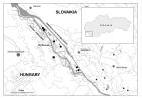
Received 14 January 2015 ~ Accepted 29 July 2015 ~ Published 13 August 2015 ~ DOI ffs.2015.20.13 ~ In English
Taxocenózy pošvatiek (Plecoptera) vodných ekosystémov v povodí Demänovky (Nízke Tatry) a ich ovplyvnenie eróziou
Stoneflies (Plecoptera) taxocenoeses of the aquatic ecosystems of the Demänovka River Basin (Low Tatras) influenced by erosion
Iľja Krno, Alena Vašková & Ferdinand Šporka
Folia faunistica Slovaca 20 (2) 2015: 113–129
Abstract: Temporal and spatial distribution patterns of lotic larval stoneflies assemblages were investigated in Demänovka river basin (West Carpathians). Qualitative and quantitative samples were performed seasonally from October 1995 to August 1997 in 13 sampling sites. The most numerous families were represented Leuctra, Protonemoura and Isoperla. Analysis of functional feeding group distribution patterns clearly showed dominance of shredders in higher reaches, and collector gatherers and predators in the middle and lower reaches. Four stoneflies species assemblages were distinguished based on PCA analysis. Using permutation test CCA analysis of 15 environmental factors we selected 3 most important, according to the stones ratio of the stream, altitude and erosion index. Taxa Brachyptera, Capnia and Protonemura nimborum are characteristic for silicate streams, while taxa Leuctra braueri and Leuctra prima for carbonate torrents. The stonefly metrics expressed as original-environmental and human impacts. High diversity values were related to the middle reaches. The significantly highest values of saprobic index were found in the lower reaches of the Demänovka stream. The significantly highest values of erosion index were found in the lower reaches of the Priečne stream (ski slopes).

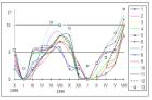

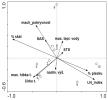
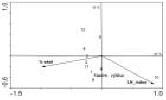

Received 6 February 2015 ~ Accepted 17 April 2015 ~ Published 20 August 2015 ~ DOI ffs.2015.20.14 ~ In Slovak, with English abstract
Kosce (Arachnida, Opiliones) pohoria Čergov
Harvestmen (Arachnida, Opiliones) of the Čergov Mts
Peter Maršalek & Slavomír Stašiov
Folia faunistica Slovaca 20 (2) 2015: 131–134
Abstract: The work deals with the results of faunistic research of the species structure of harvestman (Opiliones) communities undertaken on 9 selected localities in the southwest part of the Čergovské vrchy Mts. (Northern Slovakia) in August 2011 and July–August 2012. Harvestmen were collected individually during several one-day excursions. In total, the occurrence of 11 species from 2 families (Nemastomatidae and Phalangiidae) was recorded. The obtained material consists of 69 individuals. Communities of the investigated area were dominanted by Phalangium opilio and Lacinius ephippiatus. The record of Gyas titanus is the most important. This species belong to the protected species of harvestmen in Slovakia. The most of species are mountain or euryvalent harvestmen, usually characterized also as hygrophilous and sylvicoles. The paper presents the first data on the occurrence and the distribution of these invertebrates in the concerned territory.
Received 11 February 2015 ~ Accepted 30 March 2015 ~ Published 21 August 2015 ~ DOI ffs.2015.20.15 ~ In Slovak, with English abstract
Vážky (Odonata) chráněného areálu Arborétum Mlyňany
Dragonflies (Odonata) of the Protected Area Mlyňany Arboretum
Stanislav David & Monika Ábelová
Folia faunistica Slovaca 20 (2) 2015: 135–139
Abstract: Garden ponds are part of the area Mlyňany Arboretum. In 2009 and 2011 a total of 277 specimens of dragonflies belonging to 11 species were collected in the 7 garden ponds. Four eudominant (Ischnura elegans, Chalcolestes viridis, Sympetrum sanguineum and Coenagrion puella), one dominant (Erythromma viridulum), four subdominant (Somatochlora metallica, Anax imperator, Platycnemis pennipes, Ischnura pumilio), one recedent (Aeshna cyanea) and subrecedent (Libellula depressa) could be distinguished. Dragonfly fauna of the studied garden ponds belong to the initial (pioneer) species colonizing the small man-made garden ponds. There were six autochthonous (Platycnemis pennipes, Ischnura elegans, I. pumilio, Coenagrion puella, Erythromma viridulum and Anax imperator) and one probably autochthonous (Sympetrum sanguineum) species found. All observed species we could associate with garden ponds.
.jpeg)
.jpeg)
Received 2 February 2015 ~ Accepted 28 August 2015 ~ Published 7 September 2015 ~ DOI ffs.2015.20.16 ~ In Czech, with English abstract
Occurrence of Eubranchipus grubii (Crustacea, Chirocephalidae) in Slovakia
Denis Kuzl & Eduard Stloukal
Folia faunistica Slovaca 20 (2) 2015: 141–143
Abstract: Eubranchipus grubii (Dybowski 1860) as a typical crustacean species inhabiting temporary spring waters was reported in vernal water bodies on top of the Malé Karpaty Mts.
Received 1 August 2015 ~ Accepted 28 August 2015 ~ Published 1 December 2015 ~ DOI ffs.2015.20.17 ~ In English
Contribution to the knowledge of dragonflies (Odonata) of the Orava river basin
príspevok k poznaniu Vážok (Odonata) povodia rieky Oravy
Katarína Janeková, Stanislav David & Kornélia Petrovičová
Folia faunistica Slovaca 20 (2) 2015: 145–155
Abstract: The Orava River basin covers a total area of 1 633 km2, there are a lot of marsh habitats, mainly two major types of peatlands – bogs and fens. The authors put together a faunistic overview of the dragonfly data, which were obtained between 2010 and 2014. A total of 36 dragonfly species were identified from 16 investigated localities, detailed records are given. There are 30 species recorded as autochthonous. There are many endangered and protected species, for instance Sympecma fusca, Coenagrion hastulatum, Somatochlora arctica, Leucorrhinia caudalis, L. dubia, L. pectoralis, L. rubicunda, there are species of European importance as well. The area is characterized by a sphagnophilous dragonfly fauna, also the complex of small water bodies, the sand and gravel pits, ditches and marshes drainage channels are of a great importance too.
.jpeg)
Received 26 December 2014 ~ Accepted 25 September 2015 ~ Published 1 December 2015 ~ DOI ffs.2015.20.18 ~ In Slovak, with English abstract
First record of niphargid amphipods in region of Bratislava (Western Slovakia)
Eduard Stloukal & Denis Kuzl
Folia faunistica Slovaca 20 (2) 2015: 157–162
Abstract: Niphargus tatrensis Wrzesniowsky, 1888 has been found in springs of the Malé Karpaty Mts in Bratislava city, Slovakia for a first time. The record in western most tip of Carpathian mountains is situated outside the karstic area and forms important connection between western populations of the species known from Austria and Czech republic and eastern ones occurring in Slovakia, southern Poland and north-eastern Hungary.
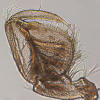
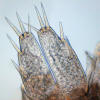
Received 1 August 2015 ~ Accepted 1 August 2015 ~ Published 28 December 2015 ~ DOI ffs.2015.20.19 ~ In English
Data on Strumigenys argiola (Emery, 1869) (Hymenoptera: Formicidae: Myrmicinae) from Slovakia
Milada Holecová, Mária Klesniaková, Adrián Purkart & Filip Repta
Folia faunistica Slovaca 20 (2) 2015: 163–166
Abstract: Records of the cryptic dacetine ant Strumigenys argiola (Emery, 1869) from four localities in western and southwestern Slovakia are presented. The territory of Slovakia represents the northern border of its known native distribution.
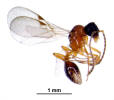






Received 25 October 2015 ~ Accepted 16 November 2015 ~ Published 28 December 2015 ~ DOI ffs.2015.20.20 ~ In English
Orthoptera and Mantodea assemblages of East Carpathian Mts (Central Europe)
Benjamín Jarčuška, Peter Kaňuch & Anton Krištín
Folia faunistica Slovaca 20 (2) 2015: 167–182
Abstract: A survey of diversity and composition of orthopterans and mantids was conducted in 56 sites of north-eastern Slovakia, five sites in south-eastern Poland and four sites in Polish-Slovak borderline from 2007 to 2015. Material was collected by sweeping herb and shrub layer and beating of lower part of tree vegetation and supplemented with individual collection of specimens. In the area we found 55 Orthoptera and one Mantodea species. The most frequent species were Chorthippus parallelus, Metrioptera roeselii and Pholidoptera griseoaptera. Detrended correspondence analysis revealed that there was continuous variation in sampled species assemblages. Thus, it was not possible to define distinct types of orthopteran assemblages in the data set. Species turnover among sites (beta diversity) was smaller for Caelifera species than for Ensifera species. Three species of European importance (Isophya stysi, Pholidoptera transsylvanica and Odontopodisma rubripes) were also found. Distributional patterns and ecology of three Habitats Directive species, four endemics and 11 other zoogeographically important species are discussed.


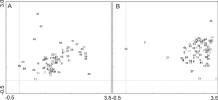
Received 27 November 2015 ~ Accepted 1 December 2015 ~ Published 28 December 2015 ~ DOI ffs.2015.20.21 ~ In English